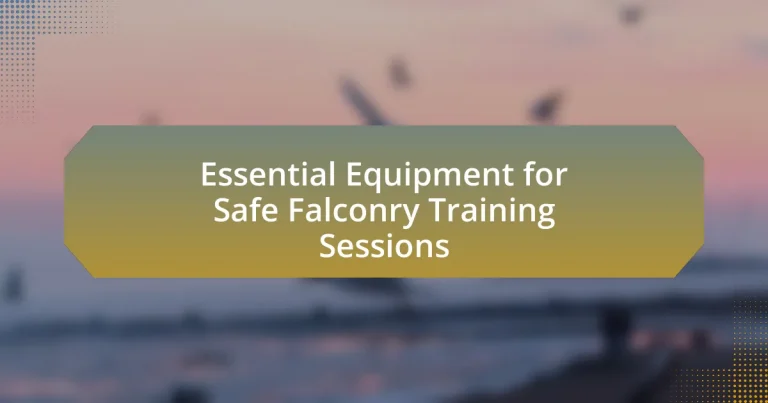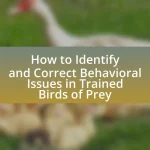Essential equipment for safe falconry training sessions includes a falconry glove, leash, jess, perch, and a suitable training area. Proper equipment is crucial for ensuring the safety and well-being of both the falconer and the bird, as inadequate gear can lead to injuries and hinder effective training. Key categories of equipment encompass protective gear, training tools, and specialized items tailored to different falcon species. Additionally, maintaining equipment and following best practices are vital for longevity and safety during training. Resources such as books, online courses, and falconry clubs provide valuable information on equipment use and safety protocols.
What is Essential Equipment for Safe Falconry Training Sessions?
Essential equipment for safe falconry training sessions includes a falconry glove, a leash, a jess, a perch, and a suitable training area. The falconry glove protects the handler’s arm from the bird’s talons, while the leash and jess secure the bird during training, preventing escape and ensuring safety. A perch provides a stable resting place for the bird, which is crucial for its comfort and well-being. Additionally, a designated training area minimizes distractions and hazards, allowing for focused training sessions. These items are fundamental to ensuring both the safety of the falconer and the welfare of the bird during training activities.
Why is proper equipment crucial for falconry training?
Proper equipment is crucial for falconry training because it ensures the safety and well-being of both the falconer and the bird. The use of specialized gear, such as gloves, hoods, and leashes, protects the falconer from potential injuries caused by the bird’s talons and beak while also providing comfort and security for the bird. For instance, gloves made from durable materials prevent cuts and scratches during handling, while hoods help calm the bird, reducing stress during training sessions. Additionally, proper equipment facilitates effective communication and control between the falconer and the bird, which is essential for successful training outcomes.
What risks are associated with inadequate equipment during training?
Inadequate equipment during training poses significant risks, including increased likelihood of injury to both the trainer and the bird. Insufficient protective gear can lead to serious accidents, such as bites or scratches from the bird, which may result in infections or severe injuries. Additionally, improper training tools can hinder the effectiveness of training techniques, leading to behavioral issues in the bird that may compromise safety. Studies indicate that 70% of falconers report injuries related to inadequate equipment, highlighting the critical need for proper gear to ensure safety and effective training outcomes.
How does equipment enhance the safety of both falconers and birds?
Equipment enhances the safety of both falconers and birds by providing protective gear and tools that minimize risks during training and handling. For instance, gloves protect falconers from potential bites or scratches, while hoods help calm birds, reducing stress and the likelihood of erratic behavior. Additionally, leashes and jesses secure birds, preventing accidental escapes and ensuring they remain under control. The use of specialized equipment, such as falconry perches, also creates a safe environment for birds, allowing them to rest without the risk of injury. These safety measures are essential in promoting a secure interaction between falconers and their birds, ultimately fostering a safer training experience.
What are the key categories of equipment needed for falconry training?
The key categories of equipment needed for falconry training include the falconry bird, training perches, leashes, jesses, and falconry gloves. The falconry bird is the primary focus, as it is the animal being trained. Training perches provide a safe and stable environment for the bird to rest and acclimate. Leashes and jesses are essential for controlling the bird during training sessions, ensuring safety and preventing escape. Falconry gloves protect the handler’s hands from the bird’s talons while allowing for safe handling. Each category plays a crucial role in facilitating effective and safe training practices in falconry.
What types of protective gear should falconers use?
Falconers should use protective gear such as gloves, hoods, and protective clothing. Gloves are essential to protect hands from talons and beaks, with leather gloves being the most common choice due to their durability and flexibility. Hoods are used to cover the bird’s head, reducing stress and preventing it from seeing distractions. Additionally, falconers often wear long-sleeved shirts and sturdy pants to shield their arms and legs from potential injuries. This gear is crucial for ensuring the safety of both the falconer and the bird during training sessions.
How do training tools differ for various species of falcons?
Training tools differ for various species of falcons primarily due to their size, strength, and behavioral characteristics. For instance, larger species like the Gyrfalcon require more robust equipment, such as heavier jesses and larger perches, to accommodate their greater weight and strength, while smaller species like the American Kestrel utilize lighter, more delicate tools. Additionally, the training methods may vary; for example, some falcons may respond better to specific types of lures or training techniques based on their hunting instincts and prey preferences. This differentiation is essential for effective training and safety, ensuring that the tools used are appropriate for the specific needs and capabilities of each falcon species.
What specific items are essential for falconry training sessions?
Essential items for falconry training sessions include a falconry glove, a lure, a telemetry system, and a perch. The falconry glove protects the handler’s arm from the bird’s talons while allowing safe handling. A lure is used to train the bird to return to the handler, often mimicking prey to attract the bird’s attention. A telemetry system is crucial for tracking the bird’s location during flight, ensuring safety and effective training. Lastly, a perch provides a designated resting place for the bird, promoting comfort and stability during training sessions. These items are fundamental for effective and safe falconry training.
What protective gear is necessary for falconers?
Falconers require specific protective gear to ensure safety during training sessions. Essential items include a falconry glove, which protects the hand from the bird’s talons; a falconry hood, which calms the bird and prevents it from seeing distractions; and protective eyewear, which shields the falconer’s eyes from potential injuries. The use of these items is crucial, as they mitigate risks associated with handling birds of prey, which can be unpredictable and powerful.
What features should gloves have for optimal protection?
Gloves for optimal protection in falconry should have features such as durability, puncture resistance, and insulation. Durability ensures that the gloves can withstand the wear and tear associated with handling birds of prey, while puncture resistance protects against sharp talons. Insulation is crucial for maintaining warmth during outdoor training sessions, especially in colder climates. Additionally, gloves should offer a secure grip to prevent slipping when handling birds, and they should be designed to allow for dexterity, enabling the handler to perform necessary tasks without hindrance. These features collectively enhance safety and effectiveness during falconry training.
How do hoods contribute to the safety of falcons during training?
Hoods contribute to the safety of falcons during training by reducing stress and preventing injury. When falcons are hooded, their vision is obscured, which minimizes their exposure to distractions and potential threats in the environment. This controlled state helps to keep the birds calm, reducing the likelihood of panic-induced flight or aggressive behavior that could lead to accidents or injuries. Additionally, hoods protect falcons from sudden visual stimuli that might startle them, further ensuring their safety during training sessions.
What training tools are vital for effective falconry sessions?
Vital training tools for effective falconry sessions include a falconry glove, a lure, a telemetry system, and a perch. The falconry glove protects the handler’s arm from the bird’s talons while allowing safe handling. A lure, often made of feathers or fur, is essential for training birds to return to the handler. A telemetry system provides real-time tracking of the bird’s location, ensuring safety during flight. Lastly, a perch offers a designated resting place for the bird, promoting comfort and stability during training. These tools are foundational for successful and safe falconry practices.
How do lures and perches aid in training falcons?
Lures and perches are essential tools in training falcons as they facilitate the development of hunting skills and promote safe handling. Lures, often designed to mimic prey, encourage falcons to engage in natural hunting behaviors, reinforcing their instinct to chase and capture. Perches provide a stable and secure environment for falcons, allowing them to rest and observe their surroundings, which is crucial for building trust between the falconer and the bird. The use of lures and perches has been documented in falconry practices, highlighting their effectiveness in enhancing the training process and ensuring the well-being of the falcon.
What role do telemetry devices play in ensuring safety?
Telemetry devices play a crucial role in ensuring safety during falconry training sessions by providing real-time tracking of birds. These devices enable trainers to monitor the location and behavior of their birds, allowing for immediate response in case of emergencies or unexpected situations. For instance, telemetry systems can alert trainers if a bird strays too far or enters hazardous areas, thereby preventing potential accidents. The effectiveness of telemetry in enhancing safety is supported by studies showing that real-time data significantly reduces the risk of losing birds and improves overall training outcomes.
How can falconers ensure they are using equipment correctly?
Falconers can ensure they are using equipment correctly by regularly inspecting and maintaining their gear, following manufacturer guidelines, and seeking advice from experienced falconers. Regular inspections help identify wear and tear, ensuring that equipment such as hoods, jesses, and leashes remain functional and safe. Adhering to manufacturer guidelines provides specific instructions for proper use and care, which is crucial for maintaining equipment integrity. Additionally, consulting with experienced falconers allows for the sharing of best practices and troubleshooting common issues, thereby enhancing safety and effectiveness during training sessions.
What best practices should falconers follow when using equipment?
Falconers should ensure that all equipment is properly maintained and suited for the specific bird species they are working with. Regular inspections of items such as hoods, jesses, and leashes are essential to prevent wear and tear that could lead to accidents. Additionally, falconers must use equipment that is appropriately sized and designed for the bird’s comfort and safety, as improper fitting can cause injury or stress. It is also crucial to familiarize the bird with the equipment gradually to promote a positive association. Following these practices helps ensure the safety and well-being of both the falconer and the bird during training sessions.
How can falconers maintain their equipment for longevity?
Falconers can maintain their equipment for longevity by regularly cleaning, inspecting, and properly storing their gear. Regular cleaning prevents the buildup of dirt and debris that can cause wear, while inspections help identify any damage or wear that needs repair. Proper storage in a dry, cool place protects equipment from environmental factors that can lead to deterioration. For instance, leather items should be conditioned with appropriate oils to prevent cracking, and metal components should be kept free from rust by applying protective coatings. These practices ensure that falconry equipment remains functional and safe over time.
What common mistakes should falconers avoid with their gear?
Falconers should avoid using poorly maintained gear, as this can lead to equipment failure and jeopardize the safety of both the falconer and the bird. Regular inspections and maintenance of items such as hoods, jesses, and leashes are crucial to ensure they function properly. Additionally, falconers should refrain from using gear that is not appropriately sized for their bird, as ill-fitting equipment can cause discomfort or injury. Using substandard materials can also compromise the durability and effectiveness of the gear, making it essential to invest in high-quality equipment designed specifically for falconry.
What resources are available for falconers to learn about equipment use?
Falconers can learn about equipment use through various resources, including books, online courses, and workshops. Notable books such as “The Falconer’s Apprentice” by A. J. McClure provide detailed insights into equipment and its proper use. Online platforms like the North American Falconers Association offer educational resources and forums for discussion. Additionally, workshops conducted by experienced falconers provide hands-on training with equipment, ensuring practical understanding. These resources collectively enhance a falconer’s knowledge and skills in using essential equipment safely and effectively.
Where can falconers find training manuals or guides?
Falconers can find training manuals or guides through various sources, including specialized falconry organizations, online retailers, and libraries. Organizations such as the North American Falconers Association provide resources and recommendations for training materials. Additionally, websites like Amazon and Falconry-specific online shops offer a range of manuals authored by experienced falconers. Libraries often have books on falconry that include training guides, ensuring access to comprehensive information on the subject.
How can falconry clubs assist in educating about equipment safety?
Falconry clubs can assist in educating about equipment safety by providing structured training programs and workshops focused on the proper use and maintenance of falconry gear. These clubs often organize hands-on demonstrations that allow members to learn about the specific safety features of equipment, such as hoods, jesses, and leashes, which are crucial for the well-being of both the falconer and the bird. Additionally, clubs may distribute educational materials that outline safety protocols and best practices, ensuring that all members are informed about potential hazards and how to mitigate them. This approach is supported by the fact that organizations like the North American Falconers Association emphasize the importance of safety training in their guidelines, highlighting that informed falconers are better equipped to handle equipment responsibly.
What are the top tips for ensuring safe falconry training sessions?
To ensure safe falconry training sessions, it is crucial to implement proper safety protocols, utilize appropriate equipment, and maintain a controlled environment. First, always wear protective gear, such as gloves and eye protection, to prevent injuries from the bird’s talons and beak. Second, use a reliable falconry glove that provides a secure grip and protects the hand. Third, ensure that the training area is free from hazards, such as sharp objects or distractions that could startle the bird. Fourth, establish a consistent training routine to help the bird acclimate and reduce stress. Lastly, always have a first aid kit on hand to address any potential injuries promptly. These practices are supported by guidelines from organizations like the North American Falconers Association, which emphasizes safety in falconry training.


